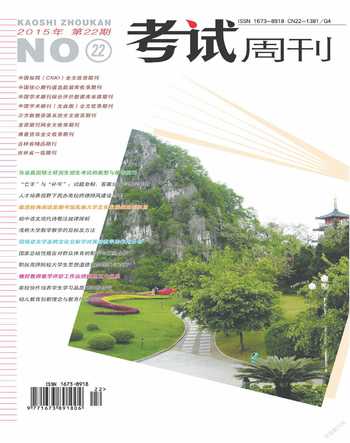揭开高考英语任务型读写的神秘面纱
宁广辉

摘 要: 任务型读写是发展学生综合运用语言能力的重要途径,主要考查考生对阅读文章中有效信息进行筛选、整合和综合概括的能力,要求考生在阅读理解的基础上,对阅读信息进行二次加工,归纳要点,整合零散信息,并根据表格的形式把加工后的信息准确、有序地表达出来。
关键词: 任务型读写 筛选 整合 概括
在《普通高中英语新课程标准》(实验)中,课程目标中明确规定:根据高中学生认知能力发展的特点和学业发展的需求,高中英语课程应强调在进一步发展学生综合语言能力的基础上,着重提高学生用英语获取信息、处理信息、分析问题和解决问题的能力,特别注重提高学生用英语进行思维和表达的能力……终结性评价中这样规定:终结性评价应以考查学生综合语言运用能力为目标。在终结性评价中,通过理解与表达的任务来检测学生运用语言知识的能力,因为英语教学中的任务指有利于学生用英语做事情的各种语言实践活动,涉及信息的吸收、处理和传递等过程,英语课程改革的重点是将综合语言运用能力作为英语学习的终极目标。正是基于任务型阅读理念的支撑,在2009年普通高等学校招生考试安徽卷英语试题中,增加了任务型读写这一新题型。
一、题型的命制特点
任务型读写是发展学生综合运用语言能力的重要途径,主要考查考生对阅读的文章中的有效信息进行筛选、整合和综合概括的能力,要求考生在阅读理解的基础上,对阅读信息进行二次加工,归纳要点,整合零散信息,并根据表格的形式把加工后的信息准确、有序地表达出来。题型结构为短文和表格,要求考生根据短文(300词左右)提供的信息,用恰当的词语完成与短文相关的表格。根据对2009年高考英语考试说明中的样题及09、10年高考英语安徽卷的真题研究,笔者发现,在设置的十个空格中,均为对实词的考查,尤其以名词为主,样题中7个是名词,1个形容词,1个动词,1个数词;2009年真题中,10个设项中考6个名词,3个形容词和1个动词。2010年高考10个设项均是实词,包括6个名词,3个动词和1个形容词。
二、解题的策略与方法
任务型读写是安徽省2009年高考英语试题中新增的一种题型,取代了沿用了十几年之久的短文改错题,在《2009年普通高等学校招生全国统一考试(安徽卷)英语说明》中,关于任务型读写是这样叙述的:任务型读写是发展学生综合运用语言能力的重要途径。考生必须在认真阅读所给短文的基础上,对短文中的有效信息进行提炼、整合,最终根据表格的设计要求,在每个空格里填写一个恰当的单词。2010年高考安徽卷英语考试说明把“提炼、整合”四个字改成了“筛选、整合与概括”六个字,广大高三教师和考生绝不能小看这三个词组、六个字的改动,这里面蕴含了任务型读写这一题型考查的三种题目及解题方法。通过对2009年高考安徽卷英语真题的研究,笔者发现,该试卷的第80题及83题考查考生对文中信息进行筛选的能力;第77题、78题、79题及85题考查考生对所提取信息进行整合转换的能力;第76题、81题、82题和84题考查考生的综合概括能力。因此,与2009年的考试说明相比,2010年的考试说明在任务型读写这一项的变化就是:换成六个字,体现三种题,成就十个空。对于“筛选、整合、概括”这六个字折射出的命题及答题策略,笔者以为最通俗的诠释是“找词、变词、概括词”。所谓“找词”,多指从所读的文章中找出单词直接填入;“变词”则是对文中单词的二度加工,改编后填入或整合转换后填入,而转换的题目多为词性转化;主/被动的转换;及物与不及物动词的转换;加前后缀的转换,等等;“概括词”即略读文章,领会文章大意,提取文中信息,总结概括归纳一个词填入,因为文章中找不到原词,所以这种题目的难度最大。在平时的英语学习及高考的冲刺中,加强对英语单词词性转换及替换词的研究与操练大有好处,例如:be of great benefit-be beneficial;be of no use-be useless;able-ability;go to foreign countries-go abroad;speed up-accelerate;I don’t know-I have no knowledge -I have no idea ;while I’m away-during my absence;in all-altogether;apply-application;arrange-arrangement;assume-assumption;Come whenever it’s convenient to you-Come at your earliest convenience;All things taken into consideration-All things considered;describe-description;development-develop;differ-different-difference;decide-decision;be full of energy-be energetic;explain-explanation;face-facial;exist-come into existence;expect-expectation;evident-evidence;fail-failure;fluent-fluency;hard-hardship;guide-guidance;intend-intention;kind-kindness;mix-mixture;prefer-preference;sign-signature;success-succeed-successful-successfully;worth-worthwhile,confused-confusing;puzzled-puzzling;invent-invention-inventor;be on time-be punctual;a wide variety of uses-varieties of uses;It was surprising that-It came as a surprise that-Surprisingly;It was hoped that-Hopefully;take the place of-replace;be well prepared for-make preparations for,等等。
三、高频词汇
当下任务型阅读这一题型是高考考生做英语题时感到最头疼的,因为阅读的文章比较长(300词左右),而且对考生的能力要求比较高,考生必须在认真阅读所给短文的基础上,对短文中的有效信息进行筛选、整合、概括,最终根据表格设计的要求,在每个空格里填写一个恰当的单词。做题的方式有多种,通常情况是先读短文,再看表格,然后定位细读,寻找所考查的信息点。这样做通常耗时多,也可以先看表格,大致了解一下表格分哪几块,做到心中有数,然后有针对性地阅读短文,边阅读边锁定考查的信息点。根据该题型的命题规律,经过大量研究,笔者发现有些单词在做任务型阅读题时的确出现的频率很高(尤其是打√的词)。现将它们归纳如下,熟练掌握,定会对做题有所裨益。
1.title 标题 √ 66.type类型、型号
2.topic(文章、演讲、讨论等的)话题 67.kind种类
3.subject 主题;课题 68.height高度
4.outline 提纲 69.weight重量;体重
5.main idea主题思想 70.shape形状
6.supporting details支持性的细节71.color颜色
7.introduction介绍;导入;入门√ 72.speed速度
8.development发展 73.rate速度、比率
9.paragraph段落 74.temperature温度
10.conclusion结论;结束√ 75.distance距离√
11.summary总结 76.style风格、方式
12.evidence证据 √ 77.material材料√
13.proof 证据 78.price价格
14.opinion看法;观点 79.health健康状况
15.views/viewpoint/point of view观点√
80.experiences经历;阅历
16.cause of ...的原因 √81.result/outcome/consequence结果
17.reason for ...的理由 √
82.effects on/influence on对……的影响√
18.question/problem/issue问题 83.analysis分析√
19.answer to回答;答案 84.population人口;人口数字
20.key to答案 85.area面积
21.solution to ...解决办法√ 86.history历史
22.ways of doing/to do ...的方法√ 87.geography地理
23.means of doing ...的方法√88.situation局势;现状;情形√
24.approach to do ...的方法/途径√ 89.background背景
25.measures/steps措施、步骤√ 90.religion宗教
26.time时间 91.attitude toward ...对……的态度√
27.place/location地点 92.contents内容
28.date日期 93.event事件
29.arrival到达 94.activities活动√
30.departure出发 95.order顺序
31.destination目的地√ 96.direction方向
32.name姓名 97.pattern图案;模式;花纹
33.age年龄 98.assessment评估
34.sex性别 99.differences不同之处√
35.marriage婚姻状况 100.similarities相似之处√
36.number数字 101.characteristics特色;特点√
37.figure数字;插图;人物;雕像
102.character性格;角色(小说、戏剧)人物
38.amount数量 103.features特点
39.quality质量;品质;素质;特性
104.appearance外貌;外表
40.quantity数量 105.personality个性
41.length长度 106.occasion场合
42.width宽度 107.tips建议;小贴士
43.size尺寸;规格;大小 108.advice建议,咨询
44.suggestion建议 109.reaction反应;回应√
45.requirements/demands要求√ 110.aspects方面√
46.condition条件√ 111.function/use功能;用途
47.food食物 112.previous/former先前的
48.clothes衣服 113.following/next接下来的;随后的
49.defination定义 √ 114.relationship关系
50.rules规则;制度 115.factors因素√
51.interview采访;面试 116.importance/significance重要性
52.comment on对……的评论117.value价值
53.plan计划 118.behaviors行为
54.examples例子 119.concerned关注;关心
55.advantages有利因素;优势 √ 120.information信息√
56.disadvantages不利因素;弊端 √ 121.instructions说明√
57.benefits益处;好处 √ 122.arrangements安排√
58.weak points弱点 123.on a daily/weekly basis按天/周√
59.strong points优点;强项 124.cases/circumstances情况√
60.course过程;课程;一道菜;河道
125.education受教育情况
61.purpose目的√ 126.hobby爱好
62.occupation职业 127.procedure程序√
63.bloodtype血型 128.process过程;进程;步骤;程序√
64.address地址 129.website网址
65.telephone电话 130.fax传真
四、实例分析:
以下是2010年高考英语安徽卷的任务型读写部分:
When difficult people express themselves orally,they generally want at least two things: they’ve been heard and they’ve been understood.As a good communicator should be a good listener,five steps are advocated toward good listening.
The first step is cooperating(合作).How does a difficult person know that you’re listening and understanding?In fact,it’s through the way you look and sound while he is talking.You may help him to fully express his thoughts and feelings.You do this by nodding your head in agreement,making certain sounds of understanding.
When the person begins to repeat what’s been said,it’s a signal of step two: turning back.It means that you repeat back some words he is using,sending a clear signal that you’re listening carefully and that you think what he is saying is important.
Having heard what he has to say,the next step is clarifying.At this point,you start to gather information about what is being communicated.Ask some open-ended questions,which will allow you to figure out what intention he is hoping to satisfy.
The fourth step is to summarize(概括) what you’ve heard.This allows you to make sure that both you and the difficult person are on the same page.When you do this,two things happen.First,if you’ve missed something,he can fill in the details(细节).Second,you’ve shown that you’re making an effort to understand completely.This increases the possibility of gaining cooperation from him.
Having listened carefully,you’ve now arrived at the point of confirming with the person that he feels satisfied that his thoughts have been fully voiced.Ask if he feels understood.
When enough sincere listening,questioning,and remembering are brought together,understanding is usually achieved and a difficult person becomes less difficult and more cooperative.
本篇文章介绍的是如何同有困难、需要求助且可能不善言辞的人沟通、交流的五步法:合作、回应、阐述、概括和确认。通过足够真诚的聆听、询问、记忆别人的倾诉,便可以达到理解对方、帮助对方排忧解难的目的。表格概括了短文的重要信息,与2009年相同,10个设项均是实词,包括6个名词,3个动词和1个形容词。虽然其中两个名词和一个动词可以直接从原文中找到,但需要考生对原文充分理解与归纳,其他7个考点均需进行不同层次的信息转换和提炼。
76.根据文章开头一句:How does a difficult person know that you’re listening and understanding? When difficult people express themselves orally,they generally want at least two things: they’ve been heard and they’ve been understood.根据第二段第一句: How does a difficult person know that you’re listening and understanding?从这两句话可以归纳出这题的正确答案应该是Listen或Listening,因为是文章讨论的话题,所以两个答案均可,均要大写。题干意为:倾听以便于理解别人。此题考查考生的综合概括能力。
77.根据文章第一段第二句:“ When difficult people express themselves orally,they generally want at least two things: they’ve been heard and they’ve been understood.”可以看出此题的正确答案是understood。 此题考查考生对文章中信息进行筛选的能力。
78.根据文章第一段:“As a good communicator should be a good listener,five steps are advocated toward good listening.”作者在为如何聆听有困难的人支招,根据表中的信息,可以概括出这一题的正确答案是Suggestions或Tips或Advice。此题考查考生的综合概括能力。
79.从文章第二段第五句“You do this by nodding your head in agreement,making certain sounds of understanding.”提取有效信息“通过会意的点头,发出某些理解性的声音便可以做到这一点”,将动名词转换为表中需要的祈使句动词,故这一题应该填Nod。此题考查考生对所提取信息进行整合转换的能力。
80.从文章第三段第二句:“It means that you repeat some words he is using …”可以看出这一题的正确答案是words。此题考查考生对文中信息进行筛选的能力。
81.从文章第四段:“Ask some open-ended questions,which will allow you to figure out what intention he is hoping to satisfy.”可以看出这一题的正确答案是intention。此题考查考生对文中信息进行筛选的能力。
82.根据文章第五段开头:“The fourth step is to summarize what you’ve heard.”可以看出表中需要的信息是名词,故正确答案是summary。此题考查考生对所提取信息进行整合转换的能力。
83.根据文章第六段开头“Having listened carefully,you’ve now arrived at the point of confirming with the person that he feels satisfied that his thoughts have been fully voiced.”提取有效信息“确认倾诉衷肠后,有困难的人获得了某种满足感”。根据表格的需要,把文中的过去分词转换成表格中需要的名词,故填satisfaction。此题考查考生对所提取信息进行整合转换的能力。
84.根据文章最后一段“When enough sincere listening,questioning,and remembering are brought together,understanding is usually achieved and a difficult person becomes less difficult and more cooperative.”提取有效信息,把less difficult转换成相同意思的另一种说法,当然应该是easier。此题考查考生对所提取信息进行整合转换的能力。
85.根据文章的开头和结尾,可以归纳出本题答案应该是hearts或minds。题干意为:倾听并理解了有困难的人便可以开启其心扉之门。此题考查考生的综合概括能力。
总之,只要了解了任务型读写的命题规律与特点,掌握了一定的技巧与方法,通过仔细阅读原文,深刻领会文章的主旨大意,再根据表格中设项的需要,对从文章中所提取的有用信息进行筛选、整合转换与综合概括,做任务型读写题就一定会得心应手,顺风顺水,游刃有余。
参考文献:
[1]普通高中英语新课程标准(实验).人民教育出版社,2003.
[2]2010年普通高等学校招生全国统一考试安徽卷英语科考试说明.

